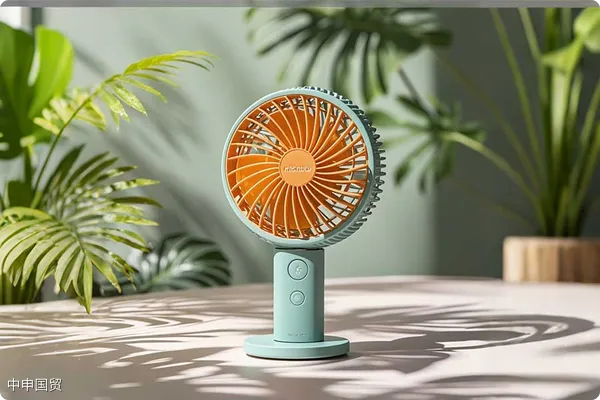- Shanghai Zhongshen International Trade Co., Ltd. - Two decades of trade agency expertise.
- Service Hotline: 139 1787 2118
In recent years, with persistent summer heatwaves worldwide, various portable mini fans have become popular cooling devices in Europe and North America, offering a more affordable alternative to expensive air conditioning. However, as market demand grows, quality and safety concerns about these fans have also drawn attention. Are you aware of the certification requirements for exporting portable mini fans to European and American markets? This article will provide a detailed overview of the relevant quality and safety risks and certification requirements, offering valuable insights for businesses.

I. Major Quality and Safety Risks
As a compact and portable small household appliance, portable mini fans are widely used but also pose certain quality and safety risks.
Battery Overheating Risks
Portable mini fans typically come with built-in lithium-ion batteries, which may overheat or even explode during charging or use, potentially causing fires. The main scenarios include:
(a) Design Defects:Overly simplistic circuit designs in portable rechargeable fans lacking effective overheating protection mechanisms may lead to battery overheating and explosions during prolonged charging or use.
(b) Substandard Materials:To cut costs, manufacturers may use non-compliant or refurbished lithium-ion batteries, which can undergo adverse chemical reactions under environmental changes or misuse, resulting in battery combustion.
(c) External Short Circuits:Some portable rechargeable fans use loose 18650-type lithium-ion batteries. The exposed metal positive and negative terminals may come into contact with metal items (e.g., keys, coins) carried by users, causing external short circuits, thermal runaway, and fires.
Chemical Hazard Risks
Materials used in portable fans may pose health and environmental hazards, primarily in the following scenarios:
(a) Excessive Harmful Substances:Printed circuit boards, battery connectors, or USB cables in mini fans may contain excessive lead or cadmium, failing to comply with the EU RoHS 2.0 Directive.
(b) Harmful Substances in Plastic Materials:Plastic casings in neck fans or desktop fans may contain high concentrations of DEHP or DBP, non-compliant with the RoHS 2.0 Directive.
(c) SCCP超标:Plastic materials in portable fan USB cables may contain excessive short-chain chlorinated paraffins (SCCPs), violating POPs regulations.
Mechanical Injury Risks
Some portable mini fans have design or structural safety hazards, mainly in the following scenarios:
(a) Child Safety Risks:Fans designed as cartoon figures or with play features may be mistaken for toys by children. Contact with fan blades could cause cuts or injuries, and small detachable parts may pose choking hazards if swallowed.
(b) Hair Entanglement Risks:Neck or desktop portable fans used close to the body may have poorly designed guards with overly large gaps, increasing the risk of hair entanglement and scalp injuries.
II. Safety Certification Requirements for Exporting to European and American Markets
Exporting portable mini fans to European and American markets requires meeting a series of strict certification requirements to ensure product safety and compliance.
EU Market Certification Requirements
Portable mini fanWhen exporting metal jewelry to the EU, especially during sample customs clearance, the requirements are often diverse. Especially in the current international environment, the EU has carried out more reviews and supervision of the origin of raw materials. The non - Russian material declaration you mentioned成员国需进行CE认证和RoHS检测。
(a) CE认证:Portable mini fans must comply with the EN 60335 series of standards for electrical and mechanical safety testing, as well as the LVD (Low Voltage Directive) and EMC (Electromagnetic Compatibility Directive).
(b) RoHS指令:Testing is required for the content of 10 hazardous substances such as lead, mercury, cadmium, and hexavalent chromium in mini fans to ensure compliance with specified limits.
(c) REACH和POPs法规:Mini fans exported to the EU must also comply with the REACH Regulation and POPs Regulation regarding restricted chemical substances and hazardous materials.
Certification requirements for the U.S. market
Portable mini fanfor containers exported to the USTypically, FCC certification and UL certification are required.
(a) FCC认证:FCC certification is the gateway for electronic and electrical products entering the U.S. market. Mini fan products must comply with the corresponding FCC certification and bear the appropriate label.
(b) UL认证:Primarily focuses on the safety performance testing and certification of electronic and electrical products. Although UL certification is not mandatory in the U.S., platforms like Amazon have recently imposed strict requirements for UL certification. Products lacking UL certification may face delisting risks.Cross-border E-commerceDomestic portable mini fan manufacturers and traders should proactively understand and master the market access requirements of Europe and the U.S., adhere to relevant technical regulations and standards, focus on key aspects such as product design, material screening, and battery management, strengthen full-chain production management, and comprehensively enhance product safety performance.
III. Customs Reminders
Pay attention to market access requirements in Europe and the U.S.
Enterprises should promptly monitor EU RAPEX notifications and U.S. CPSC recalls of portable mini fans, study and analyze the reasons for notifications and recalls, conduct self-inspections and corrections in a timely manner, and eliminate safety hazards in similar products by improving structural design and substituting raw and auxiliary materials.
Strengthen product safety certification
Strictly conduct comprehensive safety certification for portable mini fan products. Exporting to the EU requires CE certification, complying with the Low Voltage Directive (LVD), Electromagnetic Compatibility Directive (EMC), RoHS Directive, battery testing, etc. Exporting to the U.S. requires FCC certification and, if possible, UL certification to ensure safe and compliant product export and sales, avoiding delisting risks.
The demand for portable mini fans in the European and U.S. markets continues to grow, but various quality and safety issues are also increasing. By understanding and meeting the certification requirements of the European and U.S. markets, enterprises can effectively enhance product safety and competitiveness, ensuring smooth entry into the international market. We hope this article provides valuable reference and guidance for your portable mini fan export process, helping you achieve greater success in the global market.
What certifications are needed for exporting portable mini fans to Europe and the U.S.? Understanding these is essential!
Related Recommendations
© 2025. All Rights Reserved.沪ICP备2023007705号-2 PSB Record: Shanghai No.31011502009912
PSB Record: Shanghai No.31011502009912










